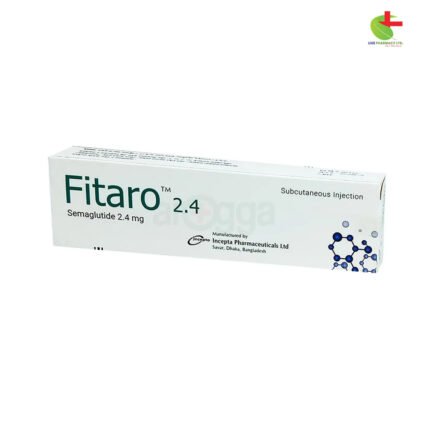Halopid 5
10.00৳ Strip
- Haloperidol is a potent antipsychotic medication.
- Effective for managing anxiety, agitation, and various psychiatric disorders.
- Alleviates symptoms like tics, nausea, and psychomotor agitation.
- Tailored dosages available for adults and children.
- Always consult a registered physician before use.
- Store below 30°C and keep out of reach of children.
 Brand
Brand
|
Incepta Pharmaceuticals Ltd |
|---|---|
 Generics
Generics
|
Haloperidol |
 Type
Type
|
Tablet |
Indications
Low Doses:
- Alleviation of nervousness, anxiety disorders, and related psychological issues such as irritability, aggressiveness, emotional instability, and insomnia.
- Relief from functional disturbances linked to anxiety, including tremors, chest tightness, gastrointestinal hyperactivity, and digestive issues.
- Treatment for tics and stuttering.
- Management of nausea and vomiting.
High Doses:
- Addressing psychomotor agitation associated with mania, dementia, acute and chronic schizophrenia, and alcoholism.
- Management of delusions and hallucinations in both acute and chronic schizophrenia, as well as acute confusion.
- Control of chorea-like movements.
- Assistance with behavioral and personality disorders in children.
- Continued treatment for tics and stuttering.
- Management of severe vomiting.
Consult a registered physician before using this medication.
Pharmacology
Haloperidol is a derivative of butyrophenone with notable antipsychotic effects, particularly beneficial for managing hyperactivity, agitation, and manic episodes. It serves as an effective neuroleptic and demonstrates antiemetic properties. Additionally, it may induce hypothermia and appetite suppression, and can enhance the effects of barbiturates, general anesthetics, and other central nervous system depressants. Haloperidol acts rapidly, with an action duration of approximately 12 hours after a single dose, and optimal daily treatment typically involves two administrations.
Dosage & Administration
Tablets:
- Adults:
- Moderate symptoms: 0.5 mg to 3.0 mg, taken 2 to 3 times daily.
- Severe symptoms: 3.0 mg to 5.0 mg, taken 2 to 3 times daily.
- Elderly patients: 0.5 mg to 4.5 mg, taken 2 to 3 times daily.
- Chronic or resistant cases: 3.0 mg to 6.0 mg, taken 2 to 3 times daily.
- Patients experiencing severe disturbances may require dosage adjustments, with daily doses reaching up to 100 mg as necessary.
Children:
- Recommended dose for managing behavioral issues in disturbed and schizophrenic children is 50 micrograms per kg of body weight.
Injection (Intramuscular or Intravenous):
- For schizophrenia and other psychotic disorders, initiate with 2-10 mg, adjusting every 4-8 hours based on response, with a maximum of 18 mg daily.
- Severely disturbed patients may need an initial dose of up to 18 mg.
- Elderly or debilitated patients should start at half the adult dose.
- Not recommended for children.
Consult a registered physician before using this medication.
Interactions
Halopid may interact with anticoagulants like phenindione, potentially affecting their efficacy. It may antagonize sympathomimetic agents, reversing the blood pressure-lowering effects of adrenergic blockers such as guanethidine. Combining Halopid with methyldopa could enhance central nervous system effects. Furthermore, it inhibits the metabolism of tricyclic antidepressants, increasing their plasma levels and the risk of toxicity. Caution is advised when using Halopid alongside antiparkinson agents, as simultaneous discontinuation could lead to extrapyramidal symptoms due to slower excretion.
Contraindications
Halopid should not be used in comatose states, severe CNS depression (e.g., due to alcohol or other depressants), severe depressive states, previous spastic diseases, lesions of the basal ganglia, or in patients with Parkinson’s syndrome, except in cases of dyskinesia from levodopa. Sensitivity to haloperidol and pre-existing Parkinson-like symptoms in the elderly are also contraindications.
Side Effects
Halopid is generally considered a safe neuroleptic, though common side effects include headache, dizziness, and insomnia. Other potential side effects may involve drowsiness, lethargy, confusion, restlessness, anxiety, euphoria, and exacerbation of psychotic symptoms, including hallucinations. Gastrointestinal issues such as dry mouth, blurred vision, urinary retention, heartburn, nausea, vomiting, and increased salivation may also occur.
Pregnancy & Lactation
The safety of Haloperidol during pregnancy and breastfeeding has not been confirmed. It is advised against administering this medication to women of childbearing age or nursing mothers unless the physician deems that the benefits outweigh potential risks to the fetus or infant, as Haloperidol is excreted in breast milk.
Precautions & Warnings
Halopid may lower seizure thresholds and has been known to induce seizures in previously controlled epileptic patients. It is crucial to maintain adequate anticonvulsant therapy when starting Halopid in these individuals. Caution is also warranted in patients with severe liver or kidney impairment and those with known allergies to neuroleptic drugs. Furthermore, caution is advised for patients with pheochromocytoma and conditions that increase the risk of seizures, such as alcohol withdrawal and brain damage. Due to its potential potentiating effects on strong analgesics or sedatives, careful consideration is necessary when prescribing Halopid to these patients.
Overdose Effects
Symptoms of overdose typically mirror and amplify known pharmacological effects, including severe extrapyramidal reactions, hypotension, or sedation. The individual may present with signs of coma, respiratory depression, and significant hypotension, potentially leading to a shock-like state.
Therapeutic Class
Butyrophenone derivatives; medications used for tremors, tics, and related disorders.
Storage Conditions
Store below 30°C. Protect from light and keep out of reach of children.













Reviews
There are no reviews yet.